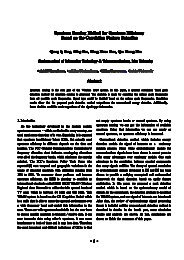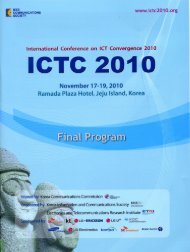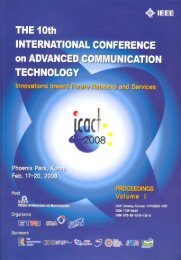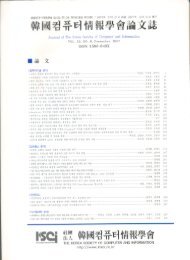Dynamic Frequency Selection in OFDMA
Dynamic Frequency Selection in OFDMA
Dynamic Frequency Selection in OFDMA
You also want an ePaper? Increase the reach of your titles
YUMPU automatically turns print PDFs into web optimized ePapers that Google loves.
<strong>Dynamic</strong> <strong>Frequency</strong> <strong>Selection</strong> <strong>in</strong> <strong>OFDMA</strong><br />
Yuq<strong>in</strong> Chen, SungHwan Shon, Sang-Jo Yoo, Jae Moung Kim<br />
Dept. of Information and Communication Eng<strong>in</strong>eer<strong>in</strong>g<br />
INHA University, Incheon, Korea<br />
E-mail: river4416@hotmail.com, kittisn@naver.com, sjyoo@<strong>in</strong>ha.ac.kr, jaekim@<strong>in</strong>ha.ac.kr<br />
Abstract—In OFDM system, dynamic frequency selection is an<br />
approach to efficiently improve the spectrum usage. Accord<strong>in</strong>g<br />
to the channel magnitude response, each user selects the<br />
subcarriers with the highest channel ga<strong>in</strong>. The exist<strong>in</strong>g algorithm<br />
divides the whole subcarriers <strong>in</strong>to partitions, and each user<br />
selects one for simplicity. To get better performance, larger<br />
number of partitions with less subcarrier is needed. The exist<strong>in</strong>g<br />
algorithm is modified by <strong>in</strong>creas<strong>in</strong>g the successful allocation<br />
probability to allocate more partitions to each user. And to<br />
guarantee cooperation among users, the higher priority to<br />
allocate is given to the user which has the largest amount of deep<br />
fad<strong>in</strong>g partitions.<br />
Keywords ⎯ Orthogonal frequency division multiplex<strong>in</strong>g,<br />
frequency selective fad<strong>in</strong>g channel, dynamic frequency selection.<br />
1. Introduction<br />
The basic pr<strong>in</strong>ciple of Orthogonal <strong>Frequency</strong> Division<br />
Multiplex<strong>in</strong>g (OFDM) is to split a high-rate datastream <strong>in</strong>to a<br />
number of lower rate streams that are transmitted<br />
simultaneously over a number of subcarriers. Because the<br />
symbol duration <strong>in</strong>crease for the lower rate parallel subcarriers,<br />
the relative amount of dispersion <strong>in</strong> time caused by multipath<br />
delay spread is decreased [1]. Due ma<strong>in</strong>ly to its ability to<br />
overcome multipath fad<strong>in</strong>g, OFDM is be<strong>in</strong>g considered as a<br />
promis<strong>in</strong>g technique to provide high data rate service.<br />
In conventional systems, the subcarriers that are assigned to<br />
each user are nonadaptively fixed <strong>in</strong> a pre-determ<strong>in</strong>ed way.<br />
Therefore, some users would suffer from poor channel effect<br />
result<strong>in</strong>g from the deep fad<strong>in</strong>g and large path loss at certa<strong>in</strong><br />
time <strong>in</strong>stant. However, the channel qualities for each user are<br />
mutually <strong>in</strong>dependent. The subcarriers that appear <strong>in</strong> deep fade<br />
to one user may not be <strong>in</strong> deep fade to other users. Therefore,<br />
to improve the system performance and capacity, we need to<br />
allocate spectrum dynamically to each user accord<strong>in</strong>g to the<br />
channel quality [2].<br />
Futhermore, many papers have proposed the way how to<br />
allocate spectrum <strong>in</strong> company with power control or adaptive<br />
modulation [3][4]. In [2], a dynamic subcarrier allocation<br />
algorithm is developed and studied <strong>in</strong> order to improve the<br />
capacity of a multi-user OFDM system <strong>in</strong> the downl<strong>in</strong>k<br />
environment. The proposed algorithm uses a decentralized<br />
approach and considers the <strong>in</strong>stantaneous channel response of<br />
each user <strong>in</strong> parallel. In order to reduce the complexity of the<br />
system, the available subcarriers are divided <strong>in</strong>to a number of<br />
partitions and the algorithms attempt to select the partition<br />
with the highest average channel ga<strong>in</strong>. However, situations<br />
may arise whereby two or more users want to select the same<br />
partition. As such, an important aspect of this algorithm is to<br />
resolve such conflicts.<br />
Whereas, this algorithm has some shortage. First of all, as the<br />
number of partitions <strong>in</strong>creases, the probability to successfully<br />
resolve the conflicts seriously decreases. Due to this reason,<br />
the whole subcarriers must be divided <strong>in</strong>to a small amount of<br />
partitions with many subcarriers. What’s more, this algorithm<br />
does not support different data rate for different users.<br />
To improve the performance, we need to divide the<br />
subcarriers <strong>in</strong>to a larger number of partitions. In this paper,<br />
modified methods are proposed to improve system<br />
performance and also to support different data rate based on<br />
the previous allocation scheme. More than one partition are<br />
allocated to each user, and one small skill is used to <strong>in</strong>crease<br />
the sucessful allocation probability. Besides, To co-operate<br />
with other users, allocation priority is considered. Higher<br />
priority is given to a user with worse subcarrier partitions. The<br />
simulation results obta<strong>in</strong>ed show that the proposed modified<br />
method outperforms the previous scheme <strong>in</strong> terms of a lower<br />
bit error rate (BER) for the same signal-to-noise ration (SNR).<br />
This paper is organized as follows. Section 2 shows the<br />
system model used <strong>in</strong> this paper. The conventional dynamic<br />
spectrum allocation algorithm and the proposed modification<br />
methods are described <strong>in</strong> Section 3. This is followed by an<br />
evaluation of its performance by computer simulation. F<strong>in</strong>ally<br />
the paper is ended up by a conclusion.<br />
2. System Model<br />
A scheme of the <strong>OFDMA</strong> system model is shown <strong>in</strong> Figure.<br />
1. In this figure, K denotes the total number of users and Nfft<br />
denotes the whole number of subcarriers. To simplify the<br />
allocation algorithm, the subcarriers are divided <strong>in</strong>to Np<br />
partitions, and each user is allowed to transmit <strong>in</strong> one or more<br />
partitions. At the transmitter, the serial datastream from the K<br />
users are fed <strong>in</strong>to the partition allocation block. Us<strong>in</strong>g the<br />
channel <strong>in</strong>formation from all K users, the partition allocation<br />
algorithm is applied to assign partitions to users. Next, data<br />
modulation is processed. The complex modulated symbols<br />
would be transformed <strong>in</strong>to time doma<strong>in</strong> by IFFT. Cyclic prefix<br />
is <strong>in</strong>serted <strong>in</strong> front of each symbol to ensure orthogonality <strong>in</strong><br />
multipath environments. The transmitted signal is then<br />
transmitted <strong>in</strong>to different frequency selective fad<strong>in</strong>g channels<br />
to different users.<br />
At the receiver, the cyclic prefix is removed to elim<strong>in</strong>ate ISI<br />
and then the time doma<strong>in</strong> samples of K users are transformed<br />
by the FFT block and then are demodulated. The adaptive
allocation <strong>in</strong>formation is used to extract the demodulated bits<br />
from the partitions to the K users.<br />
Figure 1. System model for <strong>OFDMA</strong> system based on adaptive resource<br />
allocation<br />
3. <strong>Frequency</strong> Allocation algorithm<br />
In some systems, the subcarrier allocation plan is<br />
nonadaptively fixed, which does not take <strong>in</strong>to account the<br />
channel magnitude response of each user varies <strong>in</strong>dependently.<br />
Thus certa<strong>in</strong> users may be allocated partitions that suffer from<br />
poor channel ga<strong>in</strong>s due to large path loss and serious fad<strong>in</strong>g.<br />
As an example, Figure 2 shows the channel magnitude<br />
response for four users, from which we can see for each<br />
subcarrier, some users suffer from serious fad<strong>in</strong>g while others<br />
are able to achieve a high channel ga<strong>in</strong>. Thus it is important to<br />
consider the channel magnitude response when allocate the<br />
subcarriers. Furthermore, it is necessary to adopt dynamic<br />
spectrum allocation plan due to the time variety of channel<br />
because of the mobility.<br />
3.1. Conventional Algorithm<br />
In [2], the whole subcarriers are divided <strong>in</strong>to partitions, the<br />
number of which equals to the number of users for simplicity.<br />
Each user acts <strong>in</strong> parallel and attempts to select the partition<br />
with the highest average channel ga<strong>in</strong>. However, situations<br />
may arise whereby two or more users attempt to select the<br />
same partition.<br />
The process is separated <strong>in</strong>to two phases: <strong>in</strong>itialization<br />
phase and iteration phase. In <strong>in</strong>itialization phase, the necessary<br />
<strong>in</strong>formation is assembled and conflicts between users are<br />
resolved by an iteration phase.<br />
H(f)<br />
2<br />
1.8<br />
1.6<br />
1.4<br />
1.2<br />
1<br />
0.8<br />
0.6<br />
0.4<br />
0.2<br />
0<br />
Magnitude Response<br />
1 5 9 13 17 21 25 29 33 37 41 45 49 53 57 61<br />
Subcarrier<br />
User 1<br />
User 2<br />
User 3<br />
User 4<br />
Figure 2. An example of channel magnitude response for four users.<br />
1) Initialization Phase: the whole subcarriers are divided <strong>in</strong>to a<br />
number of partitions and the average channel ga<strong>in</strong> of each<br />
partition is calculated to determ<strong>in</strong>e the set of <strong>in</strong>itial usage<br />
value for a particular user. A higher usage value implies a<br />
better channel for user, so a greater probability to select it.<br />
Conversely, a lower usage value represents a worse channel<br />
quality because most of the subcarriers with<strong>in</strong> that partition are<br />
<strong>in</strong> deep fade and thus should not be selected.<br />
2) Iteration Phase: After <strong>in</strong>itialization, the iteration phase is<br />
carried out to solve the conflict among users. Dur<strong>in</strong>g each<br />
iteration the set of usage values for each user is modified<br />
accord<strong>in</strong>g to the selected partition of the other users at the<br />
preced<strong>in</strong>g iteration. This is done by calculat<strong>in</strong>g the cost of<br />
us<strong>in</strong>g each partition for all users. The cost equals to the<br />
number of the other users that have selected the same partition.<br />
In order to resolve the conflict between users for partition<br />
allocation, the usage value should be modified <strong>in</strong> each<br />
partition. The modified usage value of each partition is based<br />
on the current usage value and the <strong>in</strong>hibition perceived by the<br />
partition under consideration. The <strong>in</strong>hibition is directly related<br />
to the cost us<strong>in</strong>g the selected partition. Consider the variables<br />
UN(t-1) as the usage value of partition N dur<strong>in</strong>g the previous<br />
iteration, CN as the cost of us<strong>in</strong>g Partition N, K as the total<br />
number of users <strong>in</strong> the system and w as the weightage factor,<br />
then the usage of Partition N dur<strong>in</strong>g the current iteration is<br />
def<strong>in</strong>ed as follows:<br />
U N ( t −1)<br />
× (1 − w)<br />
U N ( t ) = U N ( t −1)<br />
× w +<br />
C N + 1<br />
( K − 1)<br />
Therefore, the usage value of a partition that is selected by<br />
more than one user would be reduced accord<strong>in</strong>gly. Conversely,<br />
the usage value of a partition what is not selected by any user<br />
would rema<strong>in</strong> unchanged. The above process is repeated until<br />
each partition is only allocated to one user. If the allocation is<br />
(1)
unsuccessful even after the maximum number of iterations, the<br />
partitions are allocated based on some forceful criteria.<br />
The noise factor is used to <strong>in</strong>troduce some randomness <strong>in</strong><br />
the usage values so that users would not cont<strong>in</strong>uously alternate<br />
between two particular partitions.<br />
The weightage factor determ<strong>in</strong>es the weightage that is given<br />
to the usage value of a partition dur<strong>in</strong>g the iteration when<br />
calculat<strong>in</strong>g the usage value of that partition dur<strong>in</strong>g the current<br />
iteration. This prevents a user from selection with low average<br />
channel ga<strong>in</strong> due to drastic changes <strong>in</strong> usage values.<br />
3.2. Proposed Methods<br />
To improve the performance, we should divide the<br />
subcarriers <strong>in</strong>to a larger number of partitions and allocate<br />
several smaller partitions <strong>in</strong>stead of one larger partition to each<br />
user. However, it will obviously <strong>in</strong>crease the complexity and<br />
decrease the probability of successful allocation. For example,<br />
<strong>in</strong> the exist<strong>in</strong>g algorithm, when the number of iteration is fixed<br />
as 20, the probability of successful allocation is 98% as the<br />
number of partition is 8; and the probability is reduced further<br />
to 76.5% for 16 partitions. In order to reduce the complexity<br />
and improve the probability of successful allocation, we<br />
propose some modification methods as follow:<br />
Fisrt of all, the simplification of the actual case is po<strong>in</strong>ted<br />
out. We assume all of the subcarriers are used by several users<br />
fairly. The whole subcarriers are divided <strong>in</strong>to partitions which<br />
is lager than the number of users. It implies that the allocation<br />
should be competitive and shareful. One proposed<br />
modification method is follow<strong>in</strong>g:<br />
Each user assembles the average channel <strong>in</strong>formation of the<br />
whole partitions. One user can be allocated more than one<br />
partitions. Then extend the channel <strong>in</strong>formation matrix by<br />
duplicat<strong>in</strong>g the channel <strong>in</strong>formation (the number is larger, the<br />
channel is better) for each user. For example, two and three<br />
smaller partitions are allocated to two users A and B,<br />
respectively. In equation (2), A1 and B1 are the channel<br />
<strong>in</strong>formation of each partition to user A and B. A2, B2 and B3<br />
are replicas of A1 and B1. The numbers <strong>in</strong> equation (2) are<br />
assumed to be the channel <strong>in</strong>formation, and the larger number<br />
means that the channel ga<strong>in</strong> of this partition is better. In this<br />
paper, the actually used channel <strong>in</strong>formation is the frequency<br />
magnitude response of each subcarrier.<br />
⎡A1 ⎤ ⎡42,15,30,28,8 ⎤<br />
⎢<br />
A<br />
⎥ ⎢<br />
2 42,15,30,28,8<br />
⎥<br />
⎢ ⎥ ⎢ ⎥<br />
R = ⎢B ⎥ 1 = ⎢21,39,16,30,37 ⎥<br />
⎢ ⎥ ⎢ ⎥<br />
⎢B2 ⎥ ⎢21,39,16,30,37 ⎥<br />
⎢B ⎥ ⎢<br />
⎣21,39,16,30,37 ⎥<br />
⎦<br />
⎣ 3 ⎦<br />
Next, Set the largest one <strong>in</strong> A2 and B2 to zero, and set the<br />
first and second largest one <strong>in</strong> B3 to zero. It means that if we<br />
have more partitions for user B, the first, second, third and so<br />
on will be set to zero. This method is operated to reduce the<br />
conflicts probability.<br />
In the case of the same number of partition, this method<br />
simplifies the computational complexity without performance<br />
reduction. Meanwhile, the complexity reduction gives us an<br />
(2)<br />
approach to divide the subcarriers <strong>in</strong>to a larger number of<br />
partitions. And we can provide different number of partitions<br />
to different users.<br />
⎡A1 ⎤ ⎡42,15,30,28,8 ⎤<br />
⎢<br />
A<br />
⎥ ⎢<br />
2 0, 15,30,28,8<br />
⎥<br />
⎢ ⎥ ⎢ ⎥<br />
R = ⎢B ⎥ 1 = ⎢21,39,16,30,37 ⎥<br />
⎢ ⎥ ⎢ ⎥<br />
⎢B2 ⎥ ⎢21, 0, 16,30,37 ⎥<br />
⎢B ⎥ ⎢<br />
⎣21, 0, 16,30, 0 ⎥<br />
⎦<br />
⎣ 3 ⎦<br />
In this process, one situation may arise. Most partitions for<br />
one user suffer deep fad<strong>in</strong>g, and it is likely that we cannot<br />
avoid allocat<strong>in</strong>g one partition <strong>in</strong> deep fade to this user, so the<br />
performance of this user is unacceptable. In this case, we can<br />
neglect theses partitions by def<strong>in</strong><strong>in</strong>g the channel <strong>in</strong>formation<br />
to zero to show this partition is not available. When allocat<strong>in</strong>g<br />
partitions to users, a higher priority is given to this user. It<br />
means we’d better first allocate partitions to this user.<br />
In this method, the available channel <strong>in</strong>formation threshold<br />
is needed to def<strong>in</strong>e. In equation (4), we can assume that when<br />
the channel <strong>in</strong>formation is less than 10, it is unavailable.<br />
Hence B3 has the largest amount of partitions with<strong>in</strong> deep fade,<br />
to avoid allocat<strong>in</strong>g the deep fade partitions to B3, we first<br />
allocate partitions to B3.<br />
⎡A1 ⎤ ⎡42,15,30,28,0 ⎤<br />
⎢<br />
A<br />
⎥ ⎢<br />
2 0, 15,30,28,0<br />
⎥<br />
⎢ ⎥ ⎢ ⎥<br />
R = ⎢B ⎥ 1 = ⎢21,39,16,30,37 ⎥<br />
⎢ ⎥ ⎢ ⎥<br />
⎢B2 ⎥ ⎢21, 0, 16,30,37 ⎥<br />
⎢B ⎥ ⎢<br />
⎣21, 0, 16,30, 0 ⎥<br />
⎦<br />
⎣ 3 ⎦<br />
To sum up, we can see that the proposed modification<br />
methods decreases the complexity of each allocation and so<br />
supports divid<strong>in</strong>g the whole subcarriers to more partitions for<br />
users. Consequently it improves the system performance by<br />
the <strong>in</strong>creased partition number. One special case is to separate<br />
each subcarrier as one partition.<br />
If most partitions for one user appear deep fade, to avoid<br />
allocat<strong>in</strong>g one deep fade partition to that user, a higher priority<br />
is given to this user and we first allocate partition for it. These<br />
modifications make different data rate available and improves<br />
the system performance.<br />
4. PERFORMANCE ANALYSIS<br />
In this system simulation, an FFT with 64 subcarriers are<br />
allocated to 4, 8, 16, 32 users, respectively. And the proposed<br />
modification methods are simulated <strong>in</strong> frequency selective<br />
fad<strong>in</strong>g channel with AWGN. A multipath slow fad<strong>in</strong>g<br />
Rayleigh channel is used as the channel model. F<strong>in</strong>ally, it<br />
should be noted that no cod<strong>in</strong>g schemes or power control<br />
methods are employed <strong>in</strong> the system <strong>in</strong> order to test the<br />
effectiveness of the proposed algorithm.<br />
(3)<br />
(4)
The subcarrier allocation plan produced by the exist<strong>in</strong>g<br />
algorithm is dependent on the average channel ga<strong>in</strong> of each<br />
partition. One way of improv<strong>in</strong>g the performance would be to<br />
<strong>in</strong>crease the total number of partitions. Thus, the number of<br />
subcarriers with<strong>in</strong> a s<strong>in</strong>gle partition would also be reduced.<br />
Consequently, the average channel ga<strong>in</strong> would give a better<br />
<strong>in</strong>dication of the actual channel ga<strong>in</strong> of the subcarriers with<strong>in</strong><br />
that partition. However, <strong>in</strong>creas<strong>in</strong>g the number of partitions<br />
would also <strong>in</strong>evitably <strong>in</strong>crease the complexity of the system.<br />
Therefore, it is important to achieve a balance between system<br />
performance and complexity.<br />
BER<br />
1.00E+00<br />
1.00E-01<br />
1.00E-02<br />
1.00E-03<br />
1.00E-04<br />
1.00E-05<br />
1.00E-06<br />
1.00E-07<br />
BER vs SNR for Vary<strong>in</strong>g Number of Partitions<br />
4 users, 1 partition per user<br />
8 users, 1 partition per user<br />
16 users, 1 partition per user<br />
32 users, 1 partition per user<br />
0 2 4 6 8 10 12 14 16 18 20 22 24 26 28<br />
SNR(dB)<br />
Figure 3. BER vs. SNR for vary<strong>in</strong>g Number of Partitions( User<br />
No.=Partition No.)<br />
Figure 3 shows the BER performance of the conventional<br />
algorithm for vary<strong>in</strong>g number of partitions. It can be seen that<br />
as the SNR is varied from 0dB to 28dB, an <strong>in</strong>crease <strong>in</strong> the<br />
number of partitions results <strong>in</strong> a lower BER for the same SNR<br />
value.<br />
The proposed methods simplify the allocation algorithm by<br />
decreas<strong>in</strong>g the conflict probability. So the successful<br />
allocation probability is <strong>in</strong>creased. The simulation result<br />
shows that when the user number equals to 8, and partition<br />
number is 16, result<strong>in</strong>g from the modification, the successful<br />
allocation probability is raised up to 76.26% from almost<br />
2.52%. It makes divid<strong>in</strong>g the whole subcarriers to more<br />
partitions with less subcarrier available. Therefore the s<strong>in</strong>gle<br />
partition gives a better <strong>in</strong>dication of the actual average channel<br />
ga<strong>in</strong> of the subcarriers.<br />
Figure 4 shows the BER performance comparison between<br />
the exist<strong>in</strong>g allocation algorithm and the proposed method.<br />
From the figure, we can see for four users, the worst<br />
performance case is the exist<strong>in</strong>g algorithm when the partition<br />
number equals to partition number 4. In the proposed method,<br />
the partition number is <strong>in</strong>creased to 8, 16 and 32. The BER<br />
performance is improved obviously as the partition number<br />
<strong>in</strong>creases.<br />
BER<br />
1.00E+00<br />
1.00E-01<br />
1.00E-02<br />
1.00E-03<br />
1.00E-04<br />
BER vs. SNR for Vary<strong>in</strong>g Number of Partitions/same Number of Users(4 users)<br />
4 users, 1 partition per user<br />
4 users, 2 partitions per user<br />
4 users, 4 partitions per user<br />
4 users, 8 partitions per user<br />
0 2 4 6 8 10 12 14 16 18 20 22 24 26 28<br />
SNR(dB)<br />
Figure 4. BER vs. SNR for vary<strong>in</strong>g Number of Partitions with same<br />
Number of Users (User Number=4)<br />
BER<br />
1.00E+00<br />
1.00E-01<br />
1.00E-02<br />
1.00E-03<br />
1.00E-04<br />
1.00E-05<br />
1.00E-06<br />
BER vs. SNR for Vary<strong>in</strong>g Number of Partitions(8 users)<br />
8 users, 1 partition per user<br />
8 users,2 partitions per user<br />
8 users, 4 partitions per user<br />
0 2 4 6 8 10 12 14 16 18 20 22 24 26 28<br />
SNR(dB)<br />
Figure 5. BER vs. SNR for vary<strong>in</strong>g Number of Partitions with same<br />
Number of Users (User Number=8)<br />
BER<br />
1.00E+00<br />
1.00E-01<br />
1.00E-02<br />
1.00E-03<br />
1.00E-04<br />
1.00E-05<br />
BER vs. SNR for Vary<strong>in</strong>g Number of Partitions(16 users)<br />
16 users,1 partition per user<br />
16 users, 2 partitions per user<br />
1.00E-06<br />
0 2 4 6 8 10 12 14 16 18 20 22 24 26 28<br />
SNR(dB)<br />
Figure 6. BER vs. SNR for vary<strong>in</strong>g Number of Partitions with same<br />
Number of Users (User Number=16)
Figure 5 and 6 also show the BER performance comparison<br />
for 8 and 16 users, respectively. These two figures show us<br />
that when the partition number <strong>in</strong>creases to large enough (here<br />
is 32), the performance would not <strong>in</strong>crease any further because<br />
the channel ga<strong>in</strong> is <strong>in</strong>dicated sufficiently enough.<br />
5. Conclusion<br />
In this paper, modification methods to <strong>in</strong>crease the<br />
successful allocation probability are proposed to modify the<br />
exist<strong>in</strong>g algorithm. These methods are used <strong>in</strong> order to divide<br />
the whole subcarriers <strong>in</strong>to a larger number of partitions. Thus,<br />
this augment of partition number reduces the number of<br />
subcarriers with<strong>in</strong> a s<strong>in</strong>gle partition. Therefore, the average<br />
channel ga<strong>in</strong> would give a better <strong>in</strong>dication of the actual<br />
channel ga<strong>in</strong> of the subcarriers with<strong>in</strong> that partition.<br />
Simulation results describe the BER performance<br />
improvement under the same SNR value. In addition, the<br />
different data rate is supported for users.<br />
REFERENCES<br />
[1] Richard van Nee, Ramjee Prasad, “OFDM for wireless multimedia<br />
communications”, Artech House Publishers, Boston London, 2000.<br />
[2] Teo Choon Heng Alen, A. S. Madhukumar, Francois Ch<strong>in</strong>, “Capacity<br />
enhancement of a multi-user OFDM system us<strong>in</strong>g dynamic frequency<br />
allocation”, IEEE Trans .Broadcast., vol. 49, 2003, pp. 344-353.<br />
[3] Mustafa Ergen, S<strong>in</strong>em Coleri, and Prav<strong>in</strong> Varaiya,“QoS aware adaptive<br />
resource allocation techniques for fair schedul<strong>in</strong>g <strong>in</strong> <strong>OFDMA</strong> based<br />
broadband wireless access systems”, IEEE Trans. Broadcast.,<br />
vol.49,2003, pp.362-370.<br />
[4] C.Y.Wong, C.Y.Tsui, R.S.Cheng, and K.B.Letaief, “A real-time<br />
subcarrier allocation scheme for multiple access downl<strong>in</strong>k OFDM<br />
transmission,” <strong>in</strong> Proc. VTC 1999, vol.2, 1999, pp.1124-1128.
















